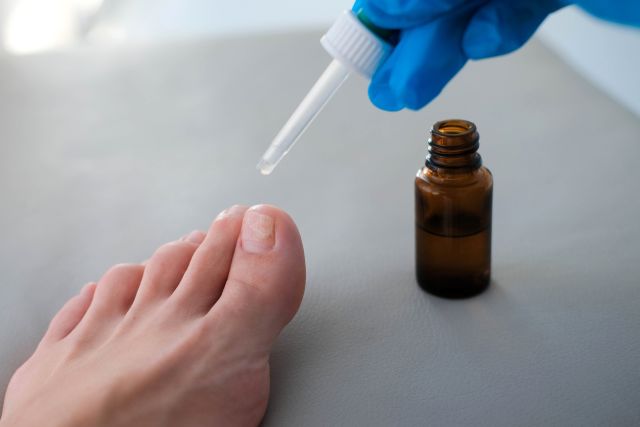Updated on September 9, 2024.
About 50 percent of people with psoriasis also have nail psoriasis. There’s also a strong link between nail psoriasis and psoriatic arthritis (PsA), and many people with more than one of these conditions at the same time.
All three conditions are autoimmune diseases, and all three are types of psoriasis. In psoriasis and nail psoriasis, the immune system grows new skin cells much faster than it should. This leads to skin rash (psoriasis) and nail discoloration, pitting, thickening, and crumbling (psoriasis of the nails). And with psoriatic arthritis, the same immune system issues cause inflammation in the joints.
Nail psoriasis can make everyday work with your hands painful. Some of the specific symptoms include:
- Brown, yellow, or white discoloration of the nails
- Blood under the nail
- Small dents in the nail (pitting)
- Thickening or buildup under the nail
- Thinning, crumbling, or fragile nails
- Onycholysis—separation of the nail from the nail bed
- Formation of horizontal grooves called Beau’s lines
Treatments
Like other nail conditions such as onychomycosis (nail fungus), nail psoriasis is difficult to eliminate. That’s because the nail itself is a tough spot to treat. The nail plate—what you think of as your finger- or toenail—acts as a suit of armor, and it’s tough for topical drugs to penetrate it.
Also, because nails grow slowly, treatment can be hard to stick to because it needs to be taken regularly as prescribed and usually takes six months or more.
Having nail psoriasis doesn’t have to stand in the way of things you enjoy. A number of treatments can help.
- Topical medications: If changes to the nail are mild and affect only a few nails, these types of medications are usually the first choice. They may include treatments derived from vitamins A and D and corticosteroids in the form of creams, ointments, or lacquers. They’re applied to the nail, especially the nail matrix, or root—the area of your finger where the nail begins to grow.
- Systemic medications: When people have psoriasis in most of their nails along with other psoriasis symptoms, healthcare providers (HCPs) may prescribe “systemic” medications. These drugs treat the whole body rather than being used as topical or targeted treatments. They’re given by mouth, by injection, or by infusion. Methotrexate and cyclosporine are two of the best-studied treatments. They are used for moderate to severe nail psoriasis, after a first-line medication has not worked adequately. Both carry the risk of severe side effects, such as damage to the liver and kidneys.
- Medicine injections: These injections around the nails are also helpful for more severe cases of nail psoriasis. This usually requires multiple doses, given every four to six weeks. Injections can be particularly helpful for treating buildup and thickening, as well as onycholysis or separation of the nails from the nail bed.
- Phototherapy: Ultraviolet (UV) light waves can slow down the overgrowth of skin cells. Sometimes phototherapy is given in conjunction with a drug named psoralen, which makes the area of diseased skin or nail more sensitive to UV rays. This combination treatment is called PUVA.
- Laser therapy: This treatment might help severe cases of nail psoriasis. Your HCP applies this therapy every six months by using a pulsed dye laser (PDL). It uses a special kind of heat, which has been converted to light, to destroy any damaged blood vessels under the nail.
- Biologic drugs: These are considered the top long-term treatment, but they have risks, as well. Since they work by suppressing the immune system, they can leave the body more vulnerable to infections.
Prevention
Taking your medication or receiving therapeutic treatments aren’t the only things you can do to control your nail psoriasis. You also need to take care of your nails in order to keep them healthy. Here are some tips to follow:
- Keep your nails short. Chipping or breaking long nails can bring on or worsen psoriasis of the nails.
- Protect your nails. Wear gloves during activities that might damage them, like gardening, housework, or manual labor. When you wash dishes, wear two layers of gloves: a cotton glove plus a glove made of vinyl or nitrile. Avoid latex gloves, as they don’t provide the protection you need.
- Keep nails natural. Avoid synthetic nails, as they raise the risk of the nail separating from the skin. Nail polish is okay—in fact, the Cleveland Clinic recommends using a nail hardener polish.
- Try not to pick or bite your nails. Disturbing the nails or the surrounding skin can cause injuries or infections that make psoriasis worse. Try to also avoid scraping at the thick buildup under your nails because it can make your nails loose and cause an infection.
- Don’t push up or cut your cuticles. Doing so can cause an infection or injury.
- Use moisturizer. Since psoriasis dries out your nails, be sure to use thick cream moisturizer often, including every time you wash your hands.
- Cut any hangnails. Get ahead of these by using nail clippers to remove them before they rip the skin and cause potential infection or aggravate your psoriasis.
Although this condition cannot be cured, the symptoms can be effectively treated. If you’re experiencing psoriasis of the nails, talk with your HCP to form a treatment plan.







